What Is Skinny Fat?
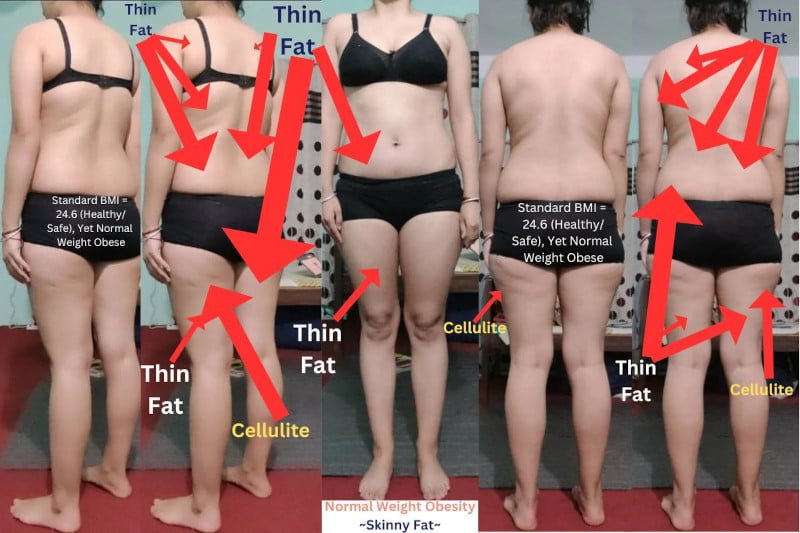
Skinny fat is a very popular phrase that is widespread across the internet, especially on social media. As a very young science, at present it is grossly misunderstood.
So, what is skinny fat science, exactly?
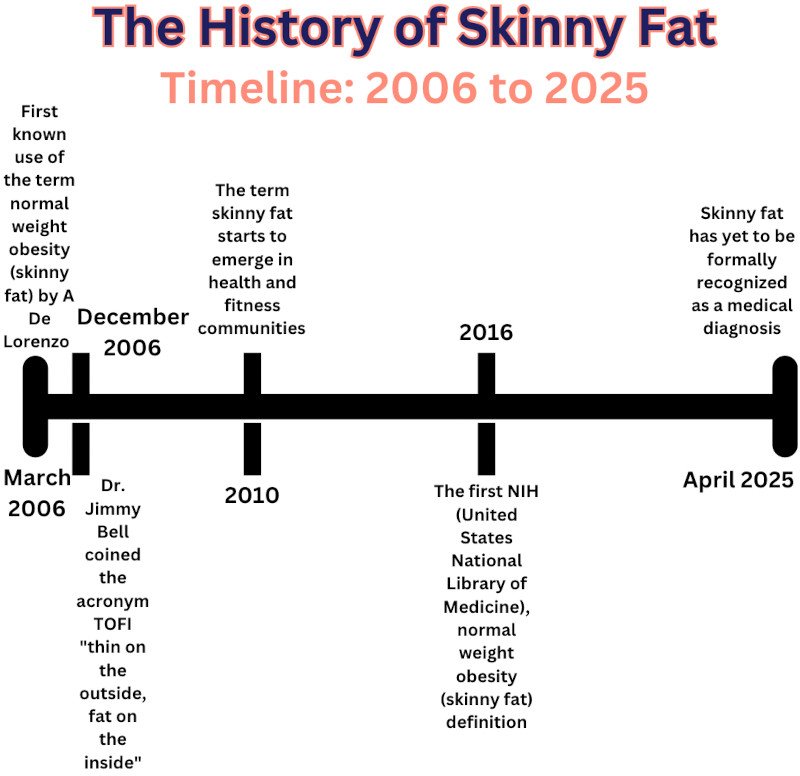 Technically, skinny fat is normal-weight obesity (NWO) and scientifically/medically defined (1) as having too much/excess body fat even when within healthy/safe/normal Standard BMI (2, 48, 49, 52), which is 18.5 to 24.99. In 2006, the first (4) known use of the term normal-weight obesity.
Technically, skinny fat is normal-weight obesity (NWO) and scientifically/medically defined (1) as having too much/excess body fat even when within healthy/safe/normal Standard BMI (2, 48, 49, 52), which is 18.5 to 24.99. In 2006, the first (4) known use of the term normal-weight obesity.
By roughly 2010, skinny fat started to emerge as a term in health and fitness communities. The first NIH normal-weight obesity definition was published in 2016 (1). As of May 2025, skinny fat is not yet formally recognized as a medical diagnosis.
What Is Skinny Fat – The Six Types
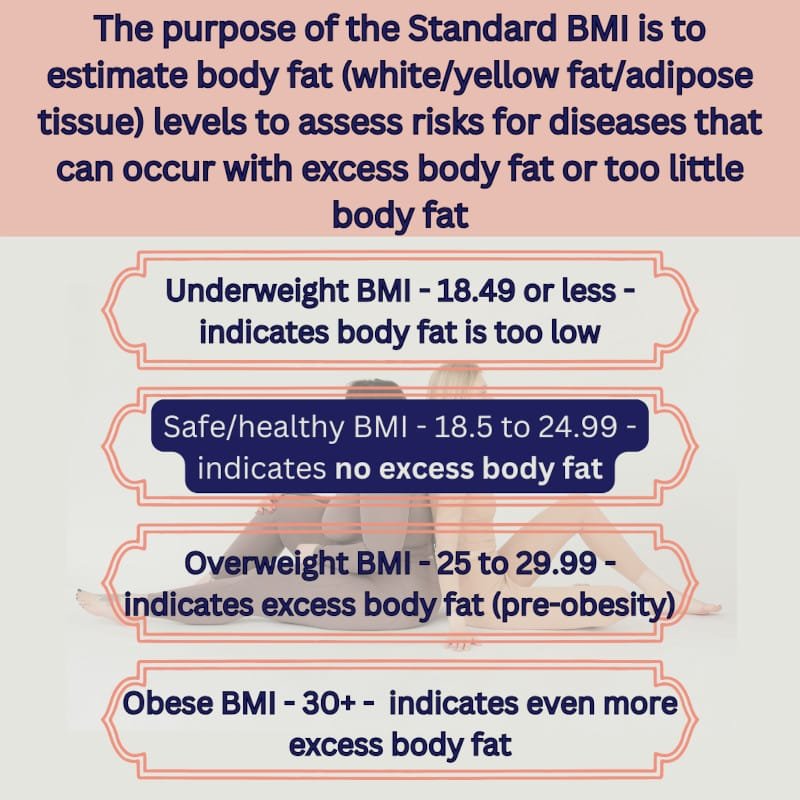
According to the Standard BMI* definition (6, 7, 8, 9, 10, 11, 48, 49, 52), once you are within safe/normal Standard BMI you no longer have any excess white fat/yellow fat (regular fat/adipose tissue) on your body and are not overweight (BMI 25 to 29.99) or obese (BMI 30+). Being skinny fat (NWO) directly contradicts the Standard BMI definition and is technically impossible.
How is it possible to be within safe Standard BMI and still have too much/excess body fat?
Our theory (50) (see MRI Study) states that skinny fat is possible because of a lack of genetic default muscle tissue. Where that genetic muscle tissue should be and is not, skinny fat exists. The “excess body fat” the person is experiencing is not excess regular white/yellow fat, it is one or more of the other 5 types of skinny fat which include:
1) Cellulite (main type),
2) Thin Fat (main type),



3) Loose Skin (typically a result of excess regular white/yellow fat weight loss and making thin fat or cellulite worse),
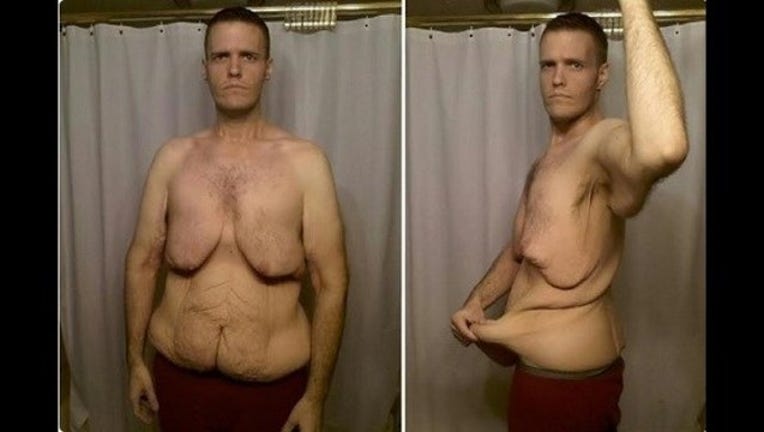
4) Saggy Skin (typically a result of excess regular white/yellow fat weight loss and making thin fat or cellulite worse), and
5) Crepey Skin (can be made worse by excess regular white/yellow fat weight loss).

As well as:
6) Normal-Weight Obesity (normal-weight obesity can only exist when someone is within safe/healthy “normal-weight” Standard BMI of 18.5 to 24.99 and can involve any of the other 5 types of skinny fat, particularly thin fat and cellulite).

Skinny fat is different than regular obesity which is defined as having too much regular white/yellow body fat (7, 8, 9, 10, 11) on your body, taking you outside safe BMI. Metabolically healthy obesity/MHO (12, 13) is defined as having normal vitals and, all things considered, being healthy yet experiencing BMI obesity. Whereas thin fat, cellulite, loose skin, saggy skin, and crepey skin can exist at any BMI, while normal weight obesity can only exist within safe/normal BMI.
Is Skinny Fat Unique Tissue?
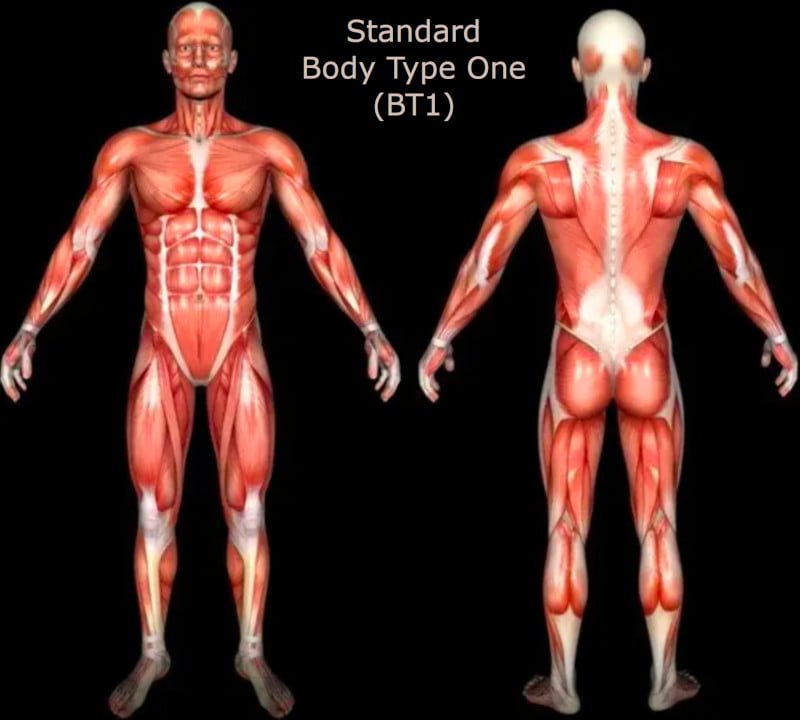
Muscle is unique tissue. Regular white/yellow fat is unique tissue.
Cellulite is unique fibrous tissue (14, 15). More than 80%+ of women (15, 16) and less than 10% of men (16) globally have cellulite, yet 0% have ever gotten rid of it. At this time, there is no FDA-approved way to permanently (15, 16) get rid of cellulite or any other type of skinny fat. You can only reduce it.
What exists when genetic muscle tissue is underdeveloped/lacking and is not present/does not exist? Thin fat. Although the science of skinny fat is young and we are not sure what kind of tissue thin fat (20, 21, 22, 23) is, the very latest science indicates that “…skinny fat cells differ from regular fat cells…” (22). We are certain that thin fat tissue is not muscle tissue or regular fat tissue. This is why 100% of eating disorder people (anorexia, bulimia, BED, etc.) like this person (57) fail to starve away skinny fat – you can technically lose 100% of your regular fat, yet your skinny fat (lack of genetic muscle tissue) will remain.
Can thin fat tissue turn into cellulite tissue or vice versa? We don’t know without more scientific research (58). But we do know that skinny fat tissue and regular fat tissue are NOT the same tissue, they are different. Visceral fat (24, 25) is only regular fat (or brown or beige fat). Skinny fat tissue — thin fat and cellulite — is unique tissue and is ONLY subcutaneous (26).
Poland Syndrome and Hypotonia

Other similar known genetic muscle disorders include Poland Syndrome (53, 54) — a lack of muscle tissue, other tissues, and bone — as well as hypotonia (27), or a lack of muscle tone/definition.
Skinny Fat Science Is Very Young and Evolving
According to Google, skinny fat is too much visceral and belly fat (subcutaneous) – which is too much regular white/yellow body fat – even when within safe BMI (which absolutely contradicts and violates the Standard BMI definition) while having low muscle mass and is caused by poor diet and exercise. There is zero science to back up this causal claim (post appropriate comments with links to legitimate scientific studies that prove otherwise).
Poor diet, exercise, and lifestyle can cause muscle tissue loss but lost muscle tissue does not magically turn into any kind of fat/skinny fat, or vice versa. Not (30, 31) how human tissue works. If poor diet, exercise, and lifestyle do cause muscle tissue loss, it can make any existing skinny fat worse (if you are genetically experiencing it).
Please explain (comment section below) how this BMI 22.7 professional trainer (28) who is experiencing skinny fat tissue (thin fat) on their love handles and lower back is experiencing excess visceral and belly fat as well as too much regular body fat and low muscle mass, and how poor diet, exercise, and lifestyle caused it:
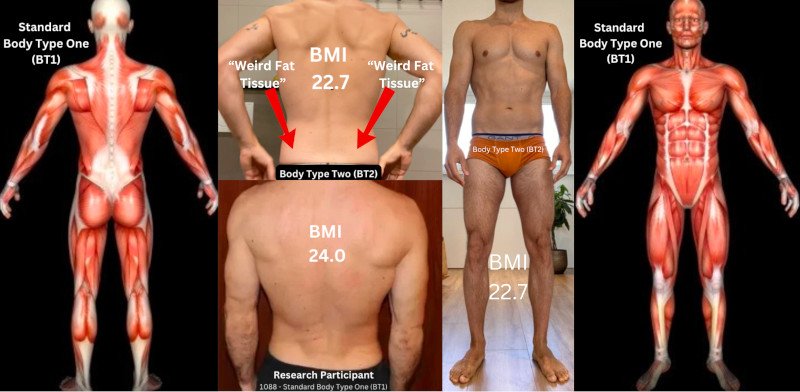
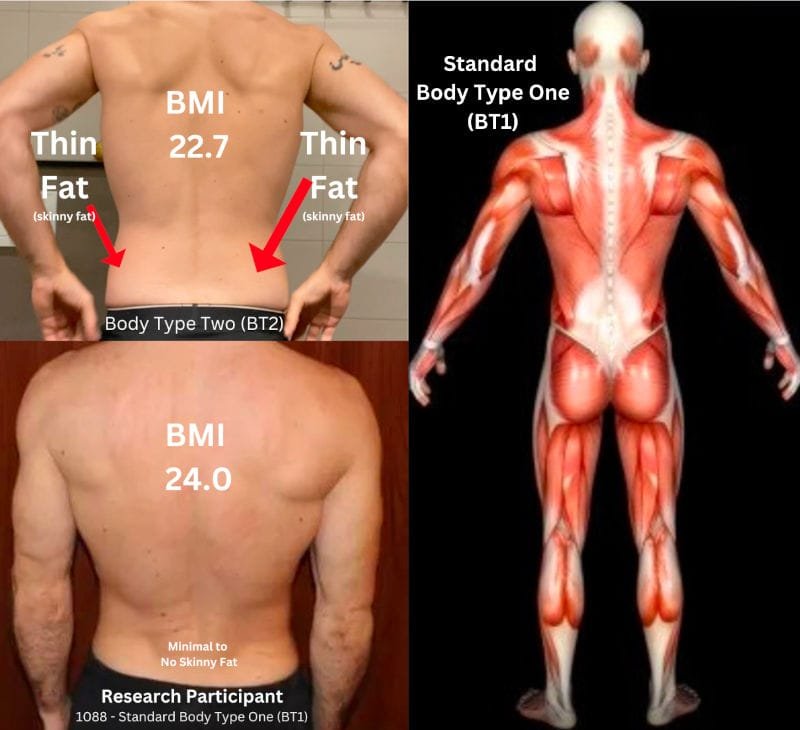

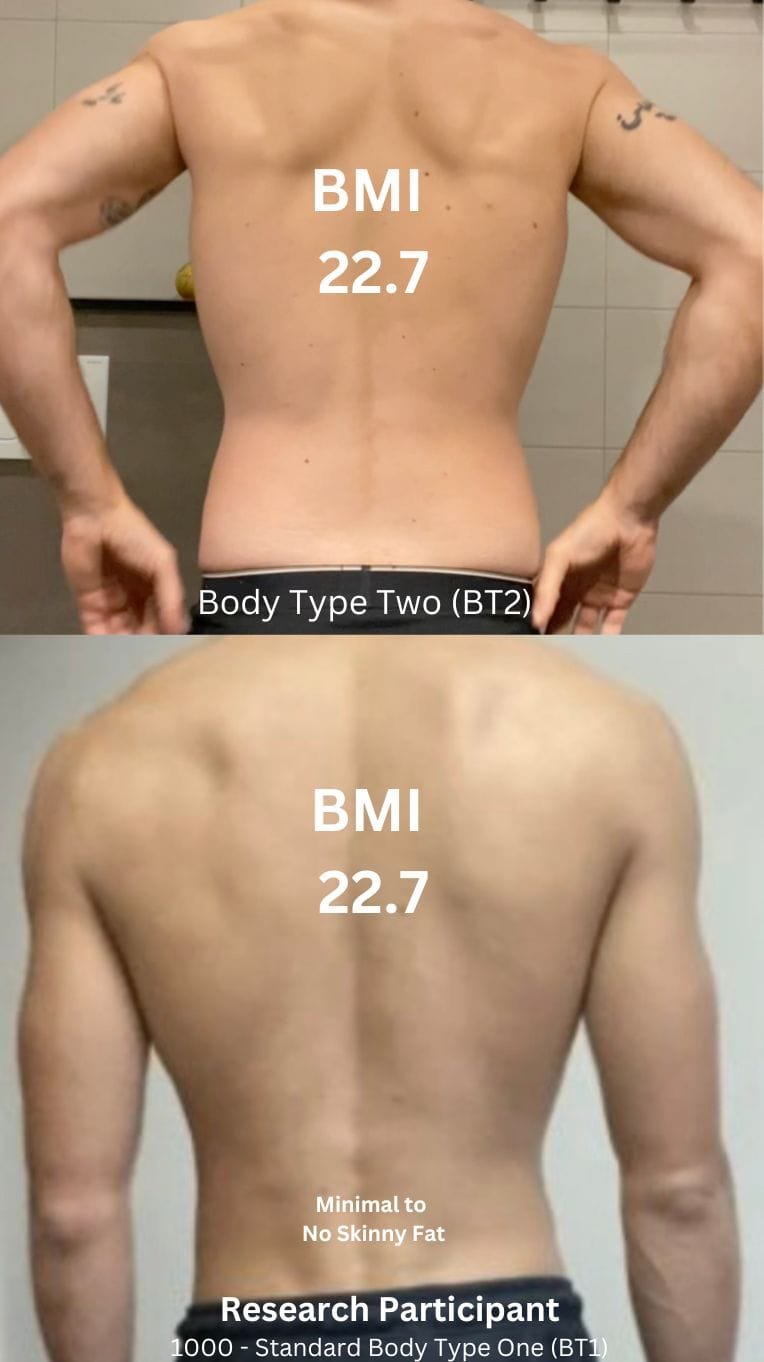
Research Participant 1170
This 23-year-old research participant (29) has a safe Standard BMI of 24.6 (three left images) with obvious skinny fat including thin fat, cellulite, and normal-weight obesity. The right three pictures are after further safe weight loss and reaching a safe Standard BMI of 21.3, yet the skinny fat remains.


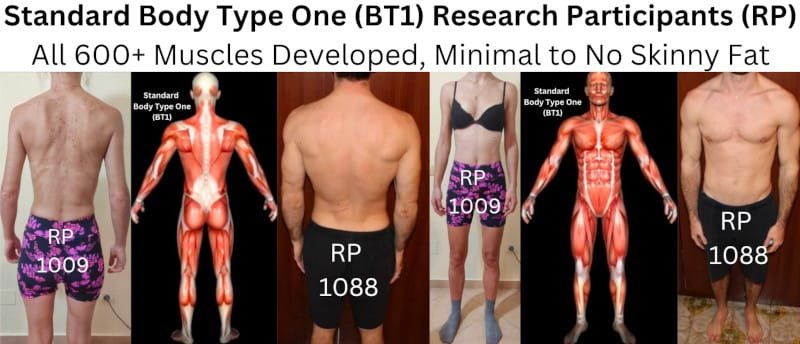 According to mainstream science/medicine, once you are within safe Standard BMI you are the Standard Body Type One (BT1) found in any scientifically approved human body anatomy book/resource (18, 19, 17) with all 600+ muscles developed. However, research participant 1170 is well within safe BMI while having indisputable skinny fat tissue where they should have default genetic muscle/mass. They are not a Standard BT1, just like the BMI 22.7 pro trainer.
According to mainstream science/medicine, once you are within safe Standard BMI you are the Standard Body Type One (BT1) found in any scientifically approved human body anatomy book/resource (18, 19, 17) with all 600+ muscles developed. However, research participant 1170 is well within safe BMI while having indisputable skinny fat tissue where they should have default genetic muscle/mass. They are not a Standard BT1, just like the BMI 22.7 pro trainer.
What Causes Skinny Fat?
The typical spiel on social media and online, in general — including most medical professionals — is that poor diet (too many carbs, too little protein), exercise (too much cardio, too little resistance), and lifestyle (lack of sleep, too much stress, poor environment) cause loss of muscle tissue and that lost muscle tissue becomes skinny fat. But, it is an undisputed scientific/medical fact that this is not how human tissue works (31, 30).
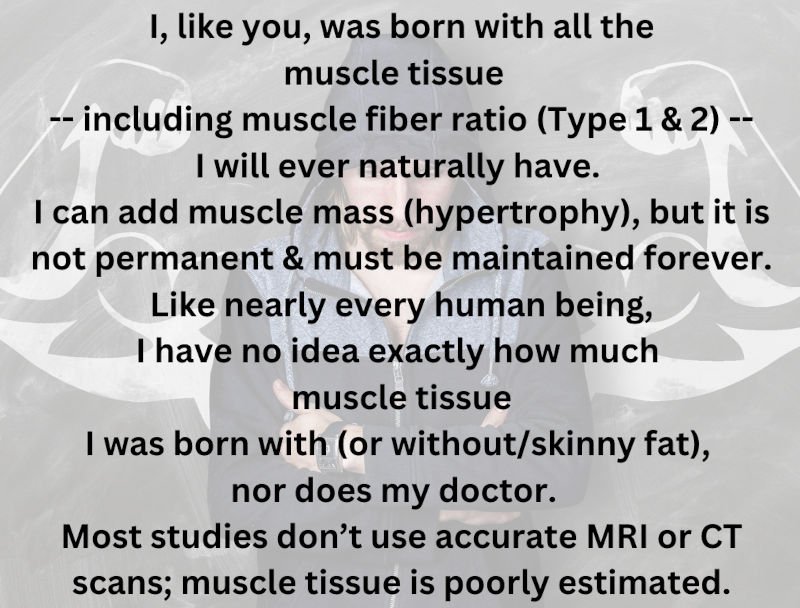 Muscle tissue cannot become any kind of fat tissue, be it regular fat, brown fat, beige fat, or skinny fat. No amount of diet/protein, exercise, or lifestyle magically turns skinny fat tissue into muscle tissue or gets rid of, prevents, or avoids skinny fat, or the like. This is not how human tissue works!
Muscle tissue cannot become any kind of fat tissue, be it regular fat, brown fat, beige fat, or skinny fat. No amount of diet/protein, exercise, or lifestyle magically turns skinny fat tissue into muscle tissue or gets rid of, prevents, or avoids skinny fat, or the like. This is not how human tissue works!
Examples of Fully Developed Genetic Default Muscle Tissue Versus Not
For example, here is Christian Bale (32), genetically blessed with a Standard Body Type One and all 600+ muscles fully developed from birth (33), after extreme weight loss for a movie role including obvious lost muscle tissue:
According to basically everyone everywhere, including medical professionals, Christian Bale should be experiencing skinny fat. But there is no sign of any type of skinny fat tissue on his body, even when he is emaciated. The muscle definition is crystal clear, even with significant loss of muscle mass.
Skinny fat is real genetic tissue (thin fat, cellulite) and is influenced by diet, exercise, and lifestyle.
Moreover, many NFL linemen are experiencing skinny fat tissue. These are top elite athletes/players — significantly less than 1%, roughly 1700 (34, 35) total players out of the entire population make the league, let alone achieve NFL starting player status — who are in the best shape of their life, yet they are experiencing skinny fat tissue where genetically they should have default muscle mass.
For instance, see the genetic skinny fat tissue (thin fat) on these two (right, left) elite NFL offensive linemen (36, 37):

And it is likely even elite three-time Super Bowl champion NFL tight end Travis Kelce (38) is experiencing skinny fat relative to his love handles and lower back, at least. Genetics. Maybe even Taylor Swift (39).


Whereas elite 4-time Super Bowl champion NFL tight end Rob Gronkowski (59) is showing no signs of experiencing any skinny fat. Genetics.

Genetics and Body Composition
Genetics is the foundation (40, 41, 42, 43, 44) of the human body and determines unique genetic body composition. Diet, exercise, and lifestyle directly influence body composition including skinny fat, but they do not determine body composition. At this time, you cannot naturally, permanently (45) change your unique genetics including skin color, hair color, eye color, height, breast size, genital size, facial features, body composition, etc. You can, indeed, temporarily (epigenetically)(46, 45) change/recomp your body composition with diet, exercise, and lifestyle. And, with enough hard work for your entire life, you may even be able to maintain the changes.
The younger you are, the more motivated you are to recomp/change your body. Then life happens, and motivation wanes for most people and you eventually return to your original default genetic body composition, like Research Participant 378 (47). Which is the current nature of human genetics. The younger you are, the harder it can be to discern skinny fat (which is only subcutaneous); especially thin fat. Body dysmorphia and skinny fat go hand-in-hand.
*Post Summary: Skinny fat is a lack of genetic muscle tissue.
*It is important to note that the Standard BMI (Body Mass Index) is the current standard — its’ first known mention in the medical literature was in July 1972 (48), it became the international standard (World Health Organization/WHO) in the early 1980s (48), and in June 1998 the U.S.A National Institute of Health approved the current BMI as the standard (49, 48) — but it is not particularly accurate. The Standard BMI fails to effectively account for genetics, excess muscle/mass (genetic or added via exercise), any type of skinny fat, race, gender, or age, no less, and is best used as a guideline. The Body Type Science Theory research (50) is working on making the Standard BMI, Standard BMR (basal metabolic rate), and Standard Body Type One (BT1) more accurate.
References
- NIH, National Library of Medicine: Normal-weight obesity syndrome: diagnosis, prevalence, and clinical implications, September 2016 (Epub Jul 29, 2016), Lana P Franco, Carla C Morais, Cristiane Cominetti. https://pubmed.ncbi.nlm.nih.gov/27473199/
- NIH, National Heart, Lung, and Blood Institute: Calculate Your Body Mass Index, https://www.nhlbi.nih.gov/health/educational/lose_wt/BMI/bmicalc.htm
- NIH, National Library of Medicine: Normal weight obese (NWO) women: an evaluation of a candidate new syndrome, December 2006 (Epub March 3, 2006), A De Lorenzo,
- ScienceDirect: Normal Weight Obesity: An Underrecognized Problem in Individuals of South Asian Descent, August 2019, Nitin Kapoor MD (Medicine), DM (Endocrine), John Furler MBBS, PhD, Thomas V. Paul MD(Medicine), DNB (Endocrine), PhD, Nihal Thomas MD (Medicine), FRCP, PhD, Brian Oldenburg MPsychol, PhD. https://www.sciencedirect.com/science/article/abs/pii/S0149291819302917
- Huffington Post: Why ‘Skinny Fat’ Can Be Worse Than Obesity, July 2015 (
- ScienceDirect: Body Mass Index, Encyclopedia of Applied Psychology, 2004. https://www.sciencedirect.com/topics/psychology/body-mass-index
- Cleveland Clinic: Obesity, https://my.clevelandclinic.org/health/diseases/11209-weight-control-and-obesity
- Wikipedia: Obesity. https://en.wikipedia.org/wiki/Obesity
- Cleveland Clinic: Brown Fat, August 2022. https://my.clevelandclinic.org/health/body/24015-brown-fat
- World Health Organization (WHO): Obesity. https://www.who.int/health-topics/obesity#tab=tab_1
- NIH, National Library of Medicine: Definitions, Classification, and Epidemiology of Obesity, May 4, 2023, Jonathan Q. Purnell, MD. https://www.ncbi.nlm.nih.gov/books/NBK279167/
- Oxford Academic: Metabolically Healthy Obesity, March 2020 (Endocrine Reviews, Volume 41, Issue 3, June 2020), Matthias Blüher. https://academic.oup.com/edrv/article/41/3/bnaa004/5780090
- Harvard Health Publishing: Overweight and healthy: the concept of metabolically healthy obesity, September 24, 2013, Patrick J. Skerrett, Former Executive Editor. https://www.health.harvard.edu/blog/overweight-and-healthy-the-concept-of-metabolically-healthy-obesity-201309246697
- NIH, National Library of Medicine: Cellulite: Current Understanding and Treatment, June 21, 2023, Allen Gabriel, Vivian Chan, Marissa Caldarella, Tanya Wayne, and Erin O’Rorke. https://pmc.ncbi.nlm.nih.gov/articles/PMC10324940/
- Mayo Clinic: Cellulite, November 21, 2023, https://www.mayoclinic.org/diseases-conditions/cellulite/symptoms-causes/syc-20354945
- Cleveland Clinic: Cellulite, October 2021. https://my.clevelandclinic.org/health/diseases/17694-cellulite
- Britannica: human muscle system, Shane W. Cummings and Robin Huw Crompton (Fact-checked by the Editors of Encyclopaedia Britannica. https://www.britannica.com/science/human-muscle-system
- Taber’s Medical Dictionary: muscle, https://www.tabers.com/tabersonline/view/Tabers-Dictionary/765961/all/muscle
- Healthline: Muscular (System), January 21, 2018, The Healthline Editorial Team (Medically reviewed by the Healthline Medical Network). https://www.healthline.com/human-body-maps/muscular-system#1
- US News: Could Having ‘Skinny’ Fat Cells Encourage Weight Gain?, Dennis Thompson (HealthDay), May 13, 2024. https://www.usnews.com/news/health-news/articles/2024-05-13/could-having-skinny-fat-cells-encourage-weight-gain
- NIH, National Library of Medicine: Thin Fat Obesity: The Tropical Phenotype of Obesity, March 2021, Nitin Kapoor, MBBS, MD. https://www.ncbi.nlm.nih.gov/books/NBK568563/
- Eat This, Not That!: ‘Skinny’ Fat Cells May Be Why You’re Gaining Weight, June 6, 2024, Kristen Carli, MS, RD (Fact checked by Alexa Mellardo). https://www.eatthis.com/skinny-fat-cells-weight-gain/
- Sky News: Skinny fat cells may lead to weight gain in future, May 21, 2024, Mickey Carroll. https://news.sky.com/story/skinny-fat-cells-may-lead-to-weight-gain-in-future-13140658
- Cleveland Clinic: Adipose Tissue (Body Fat), August 18, 2022, https://my.clevelandclinic.org/health/body/24052-adipose-tissue-body-fat
- NIH, National Library of Medicine: Switching harmful visceral fat to beneficial energy combustion improves metabolic dysfunctions, February 23, 2017, Xiaoyan Yang, Wenhai Sui, Meng Zhang, Mei Dong, Sharon Lim, Takahiro Seki, Ziheng Guo, Carina Fischer, Huixia Lu, Cheng Zhang, Jianmin Yang, Meng Zhang, Yangang Wang, Caixia Cao, Yanyan Gao, Xingguo Zhao, Meili Sun, Yuping Sun, Rujie Zhuang, Nilesh J Samani, Yun Zhang, and Yihai Cao. https://pmc.ncbi.nlm.nih.gov/articles/PMC5313060/
- Skinny Fat Science: Are Regular Fat and Skinny Fat the Same Thing?, August 28, 2024. https://skinnyfat.fellowone.com/are-regular-fat-and-skinny-fat-the-same-thing/
- Wikipedia: Hypotonia. https://en.wikipedia.org/wiki/Hypotonia
- Skinny Fat Science: Skinny Fat Love Handles, February 19, 2025. https://skinnyfat.fellowone.com/skinny-fat-science/skinny-fat-love-handles/
- Fellow One Research: Body Type Test (Quiz) Results 1170 – Body Type Three (BT3) Female (Woman), Generation Z, February 2022. https://www.fellowone.com/fellow-one-research/the-four-body-types/body-type-quiz/body-type-test-quiz-results-1170-body-type-three-bt3-female-woman-generation-z/
- Healthline: Does Fat Turn into Muscle? What to Know, March 2, 2021, Katey Davidson, MScFN, RD, CPT (Medically reviewed by Jake Tipane, CPT). https://www.healthline.com/nutrition/does-fat-turn-into-muscle
- NIH, National Library of Medicine: Muscle-to-fat interaction: a two-way street?, January 1, 2010, Bente K Pedersen. https://pmc.ncbi.nlm.nih.gov/articles/PMC2821541/
- Fellow One Research: Christian Bale Physique – Celebrity Body Type One (BT1), Male. https://www.fellowone.com/fellow-one-research/the-four-body-types/celebrity-body-types/christian-bale/celebrity-body-type-one/
- Skinny Fat Science: Is Muscle/Mass Genetic and How Does It Affect Skinny Fat?, November 20, 2024. https://skinnyfat.fellowone.com/is-muscle-mass-genetic-and-how-does-it-affect-skinny-fat/
- BETMGM, Football: How Many Active NFL Players Are There?, September 24, 2024. https://sports.betmgm.com/en/blog/nfl/how-many-active-nfl-players-are-there-bm25/
- Wikipedia: NFL Players Inc. https://en.wikipedia.org/wiki/NFL_Players_Inc.
- Men’s Health: The Perfect Football Body Is a Myth, August 15, 2023, Matt Gagne. https://www.menshealth.com/fitness/a44727338/nfl-training-camp-2023-tips/
- Sports Illustrated: Weight presents double-edged sword for linemen prospects, April 3, 2023, Austin Murphy. https://www.si.com/nfl/2013/04/03/2013-nfl-draft-chance-warmack
- Fellow One Research: Travis Kelce Physique – Celebrity Body Type Two (BT2), Male. https://www.fellowone.com/fellow-one-research/the-four-body-types/celebrity-body-types/travis-kelce-physique/celebrity-body-type-two/
- Fellow One Research: Taylor Swift Figure – Celebrity Body Type One (BT1), Female. https://www.fellowone.com/fellow-one-research/the-four-body-types/celebrity-body-types/taylor-swift/celebrity-body-type-one/
- NIH, National Library of Medicine: CHAPTER 1, GENETICS 101.https://www.ncbi.nlm.nih.gov/books/NBK115568/
- ScienceDirect: Body Composition, Encyclopedia of Endocrine Diseases (Second Edition), 2019. https://www.sciencedirect.com/topics/biochemistry-genetics-and-molecular-biology/body-composition
- NIH, National Library of Medicine: Brain Basics: Genes and the Brain, https://www.ninds.nih.gov/health-information/public-education/brain-basics/brain-basics-genes-and-brain
- Fitnescity: Body Composition: Nature or Nurture?, February 16, 2023. https://www.fitnescity.com/blog/body-composition-nature-or-nurture
- Novo Nordisk Foundation: The Same Genes Determine Fitness and Fatness, December 27, 2016, Morten Busch. https://novonordiskfonden.dk/en/news/the-same-genes-determine-fitness-and-fatness/
- Skinny Fat Science: How To Fix Skinny Fat, July 27, 2024. https://skinnyfat.fellowone.com/how-to-fix-skinny-fat/
- Skinny Fat Science: Can I Have A Skinny Fat Body And Be Fit & Healthy?, October 30, 2024, https://skinnyfat.fellowone.com/can-i-have-a-skinny-fat-body-and-be-fit-and-healthy/
- Fellow One Research: Research Participant 378 – Body Type Two (BT2) Male (Man), Millennial (Generation Y). https://www.fellowone.com/fellow-one-research/the-four-body-types/body-type-quiz/research-participant-378-body-type-two-bt2-male-man-millennial-generation-y/
- Wikipedia: Body mass index, https://en.wikipedia.org/wiki/Body_mass_index
- The New York Times: U.S. to Widen Its Definition Of Who Is Fat, June 04, 1998, The Associated Press. https://www.nytimes.com/1998/06/04/us/us-to-widen-its-definition-of-who-is-fat.html
- Fellow One Research: Body Type Science Research Data. https://www.fellowone.com/category/fellow-one-research/the-four-body-types/body-type-science/body-type-quiz/research-data/
- The Guardian: Are you a Tofi? (That’s thin on the outside, fat inside), December 10, 2006. https://www.theguardian.com/science/2006/dec/10/medicineandhealth.health
- Cleveland Clinic: Body Mass Index (BMI), May 29, 2022. https://my.clevelandclinic.org/health/articles/9464-body-mass-index-bmi
- National Institutes of Health (United States Department of Health and Human Services) – National Center For Advancing Translational Sciences, Genetic and Rare Diseases Information Center: Poland syndrome, https://rarediseases.info.nih.gov/diseases/7412/poland-syndrome
- Wikipedia: Poland syndrome. https://en.wikipedia.org/wiki/Poland_syndrome
- Fellow One Research: Body Type Test (Quiz) Results 1000 – Body Type One (BT1) Male (Man), Millennial (Generation Y). https://www.fellowone.com/fellow-one-research/the-four-body-types/body-type-quiz/body-type-test-quiz-results-1000-body-type-one-bt1-male-man-millennial-generation-y/
- Fellow One Research: Body Type Test (Quiz) Results 1088 – Body Type One (BT1) Male (Man), Millennial (Generation Y). https://www.fellowone.com/fellow-one-research/the-four-body-types/body-type-quiz/body-type-test-quiz-results-1088-body-type-one-bt1-male-man-millennial-generation-y/
- DailyMail: From anorexic to body builder: Woman who was on the brink of death after dropping to FOUR STONE becomes a champion weight lifter in just 18 MONTHS, April 4, 2017, Martha Cliff. https://www.dailymail.co.uk/femail/article-4378340/Recovering-anorexic-wins-bodybuilding-title.html
- Skinny Fat Science: Scientific Skinny Fat MRI Study – Proving What Skinny Fat Is, March 26, 2025. https://skinnyfat.fellowone.com/skinny-fat-science/scientific-skinny-fat-mri-study-proving-what-skinny-fat-is/
- Fellow One Research: Rob Gronkowski Physique – Celebrity Body Type One (BT1), Male. https://www.fellowone.com/fellow-one-research/the-four-body-types/celebrity-body-types/rob-gronkowski-physique/celebrity-body-type-one/










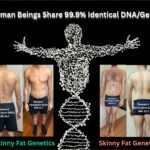




This helps explain the asian phenotype.
The MRI Study will help clarify things even further.
MRI study sounds very interesting
Stay tuned!
Pseudoscience , skinny fat is excess fat at normal body weight
There is no science to back up that psuedoscience claim. But do send links to all the studies that support the NIH 2016 definition of skinny fat/normal weight obesity. Science has to start somewhere, and that 2016 definition is just that, a start. But skinny fat is a lack of genetic muscle. The copious skinny fat articles on this site reference the latest science supporting that skinny fat is a lack of genetic muscle. Not to mention that, as per The Standard BMI, it is impossible to be within safe BMI and have too much/excess regular white/yellow body fat.
Our MRI Study is working on proving what skinny fat is, once and for all.
I always wondered if I ever had the muscle the start with and suspected genetics while everyone told me genetics are an excuse. Thank you for this great article.
🤓
Would like to see the MRI study data?
We are working on funding, please spread the word.
Fascinating science that I did not consider until now.
Questions are welcome.
how do i get rid of my skinny fat, i have thin fat
You have to add muscle mass anywhere you are experiencing skinny fat.
See the articles
How To Fix Skinny Fat
and
The Best Skinny Fat Diet, According to Science
and
The Best Skinny Fat Exercise, According to Science
helpful
🤓
finally something based on real science offering real solutions
We aim to please!
Howdy! I followed all the advice on social media to get rid of skinny fat but I’m not seeing any results. I think it is worse now. Help!
Please browse the site thoroughly as we have many articles on diet, exercise, and lifestyle for skinny fat. If you then have any specific questions, feel free to ask.
I love the fact that someone took their time to help us deal with our skinny fat problem.
Happy to help.
I thought my skinny fat is genetic but everyone told me I was just making excuses so now I know what the science says.
thanks
Glad the article helps.
nice article
Let us know if you have any questions.
this is not what skinny fat is do a google search and you will see
Google is wrong and will soon reflect the latest science in this article.
It’s hard to come by experienced people on this subject, however, you seem like you
know what you’re talking about! Thanks for all this useful science.
Thin fat and cellulite and I was figureing genetics for awhile.
Not sure.
This helpful info makes my skinny fat and weight problems finally makes sense.
Interesting